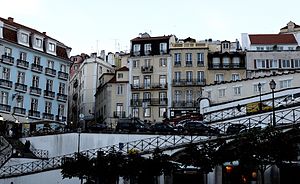
Back Bairro Alto Catalan Bairro Alto German Barrio Alto de Lisboa Spanish Bairro Alto Basque Bairro Alto French Bairro Alto Galician Bairro Alto Italian バイロ・アルト Japanese Bairro Alto Dutch Bairro Alto Occitan
Bairro Alto | |
|---|---|
 | |
| Municipality | Lisbon |
| Freguesia | Misericórdia |
| Foundation | 1487 |
Bairro Alto (Portuguese pronunciation: [ˈbajʁu ˈaltu]; literally: Upper District) is a central district of the city of Lisbon, the Portuguese capital. Unlike many of the civil parishes of Lisbon, this region can be commonly explained as a loose association of neighbourhoods, with no formal local political authority but social and historical significance to the urban community of Lisbon and of Portugal as a whole.
The bairro or "neighbourhood" resulted from urban expansion in the 16th century, forming outside the walls of the historical city, and is characterized by an almost orthogonal tract (developing from two phases of distinct urbanization).[1]
It is a fundamental quarter of Lisbon, organized into a hierarchical scheme of roads and lanes: the roads, the structural axis, run perpendicular to the river; and the lanes, or secondary axis, cut parallel to the river.[1] The matrix of allotments reflects the persistent use of the medieval layout; the division and multiplication of this module had its origin in the variations of the architectural typology. The space constructed is dominated by living spaces implanted in long narrow lots, three to four storeys in height, with asymmetric facades consisting of windows along the various storeys and staircases along the lateral flanks. Although less representative, the Pombaline-era buildings are common, essentially introducing modifications to the level of the façade's composition.[1] Although there are many typological variations to the facade designs, certain elements are repeated, such as the corners, bay and sill windows, eaves and attics, securing a homogeneous urbanized front.[1]
- ^ a b c d Morgado, Cláudia (2003), SIPA (ed.), Bairro Alto de São Roque (v. PT031106150275) (in Portuguese), Lisbon, Portugal: SIPA – Sistema de Informação para o Património Arquitectónico, archived from the original on 6 April 2015, retrieved 26 April 2012


